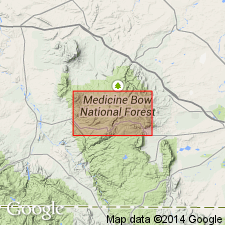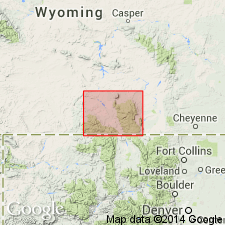
- Usage in publication:
-
- Magnolia Formation
- Modifications:
-
- Named
- Reference
- Dominant lithology:
-
- Conglomerate
- Quartzite
- AAPG geologic province:
-
- Northern Rocky Mountain region
Summary:
Named as oldest formation (of 6) of Deep Lake Group (raised in stratigraphic rank) in Medicine Bow Mountains, WY. Source of name Magnolia not stated. Type section designated and measured at SE1/4 NW1/4 and SW1/4 NE1/4 sec 10, T16N, R80W, Carbon Co, WY, Northern Rocky Mountain region; type includes surface and subsurface data. Reference section 656+ ft thick (incomplete) designated east of Stamp Mill Lake, NW1/4 SW1/4 sec 15 and NE1/4 SE1/4 sec 16, T16N, R80W. Is 1,814 ft thick at type where is divisible into a lower or conglomerate member (633 ft thick) of very coarse grained polymictic conglomerate and coarse-grained, poorly to moderately well sorted arkosic radioactive quartzite, and some mafic tuff layers; and an upper or quartzite member (1,181 ft thick) coarse-, medium-, fine- to very fine grained quartzite; both members of fluvial origin. The radioactive conglomerates probably derived from nearby source. Conglomerate in lower member has clasts of vein quartz, quartzite, mafic rock, felsic gneiss up to 15 mm in diameter. Some quartzite in upper member speckled with megacrysts of chlorite and biotite several mm in diameter; some cross-bedded; some trough cross-bedded. Lower contact placed at top of highest metabasalt of Phantom Lake Suite (new). Upper contact gradational with finer grained, less arkosic quartzite of Lindsey Quartzite (new) of Deep Lake. Of Early Proterozoic age. Geologic map; stratigraphic charts.
Source: GNU records (USGS DDS-6; Denver GNULEX).

- Usage in publication:
-
- Magnolia Formation*
- Modifications:
-
- Revised
- AAPG geologic province:
-
- Northern Rocky Mountain region
Summary:
A unit recognized in WY, Northern Rocky Mountain region. In the Medicine Bow Mountains, Magnolia unconformably overlies Conical Peak Quartzite (new) of Phantom Lake Metamorphic Suite, is the basal formation (of five) of the Deep Lake Group of the newly named Snowy Pass Supergroup, and underlies the Lindsey Quartzite of the Deep Lake Group of the Snowy Pass Supergroup. In the Sierra Madre, Magnolia unconformably overlies Bridger Peak Formation (formerly assigned to Libby Creek Group) of Phantom Lake Metamorphic Suite, is the basal formation (of six) of the lower part of Snowy Pass Group, and underlies Singer Peak Formation of the Snowy Pass. Divided into basal conglomerate member (0-330 m thick) and upper quartzite member (400-600 m thick) in Medicine Bow Mountains. Is undivided and 0-460 m thick in the Sierra Madre. Stratigraphic tables. Early Proterozoic age. Geologic map.
Source: GNU records (USGS DDS-6; Denver GNULEX).
For more information, please contact Nancy Stamm, Geologic Names Committee Secretary.
Asterisk (*) indicates published by U.S. Geological Survey authors.
"No current usage" (†) implies that a name has been abandoned or has fallen into disuse. Former usage and, if known, replacement name given in parentheses ( ).
Slash (/) indicates name conflicts with nomenclatural guidelines (CSN, 1933; ACSN, 1961, 1970; NACSN, 1983, 2005, 2021). May be explained within brackets ([ ]).

